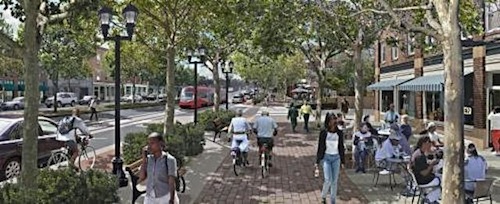We know what millennials want out of cities, and we know how that influences the most desirable companies to work for, and we even know a little about how it affects domestic migration patterns. Now we know what it’s doing to the future of real estate development — it’s hastening the shift towards “walkable urban places,” or WalkUPs:
“The last time we saw a structural change like this was back in the ’40s and ’50s,” said Christopher Leinberger, one of the authors of the report. “It’s going to take 20 to 30 years to catch up with pent-up demand.”
This is all coming off a study from Smart Growth America, which took the 30 largest U.S. cities and ranked them for walkable urbanism. They found 558 such areas across those 30 cities — the most were in DC, NYC, and Boston, as you might expect — and found that while they (the highly-walkable areas) take up only 1 percent of actual acreage, they account for 50 percent of office, retail, hotel and apartment square footage. Put simply: people like to be in areas where they can walk to other stuff, which also explains why rents for more walkable areas command a 74 percent higher premium over non-walkable areas. That’s the societal shift — see that first link up top — that real estate developers must focus on now.
Another interesting development:
The researchers projected that when it comes to the potential for future walkable development, Miami, Atlanta, Detroit, and Denver are in the top nine, and they see Los Angeles as making some serious moves forward as well, thanks in part to its heavy ongoing investment in mass transit.
Out of those, Denver I can easily see. Los Angeles is always going to be a car-first city, as is Miami (there are status symbol elements in those cities, too). I could see Detroit heading into its new renaissance on the power of walkable urban areas — get those hipsters back, Motown! Atlanta has a whole slew of issues related to mass transit, which has never been the centerpiece of building in the American Southeast.
This is also important:
In a conference call, Leinberger and others noted that walkable urban developments are not as easy to execute as the “formula product” that characterizes drivable suburban development, in part because of NIMBYism but also because of more complex permitting and review processes in urban locations.
NIMBY = Not In My Back Yard. The other thing here is: it’s easy to plan a sprawling suburban complex, for the most part. People want those stores out there, etc. It’s much harder to plan something for downtown, as noted above. One interesting issue around all this, also cited in the report, is the increasing factor of cost. Look — these cities and areas are being built, ultimately, to attract millennials. Baby Boomers are set in where they’re living, for the most part. The problem is, millennials aren’t exactly raking in the dough right now, so it doesn’t matter if Denver becomes the very modern major of a modern major city, because if no one can really afford it, well … who’s gonna live there? They’re gonna live in a section they can afford. Real estate needs to keep up with social shifts, but it needs to do so in the context of cost.
